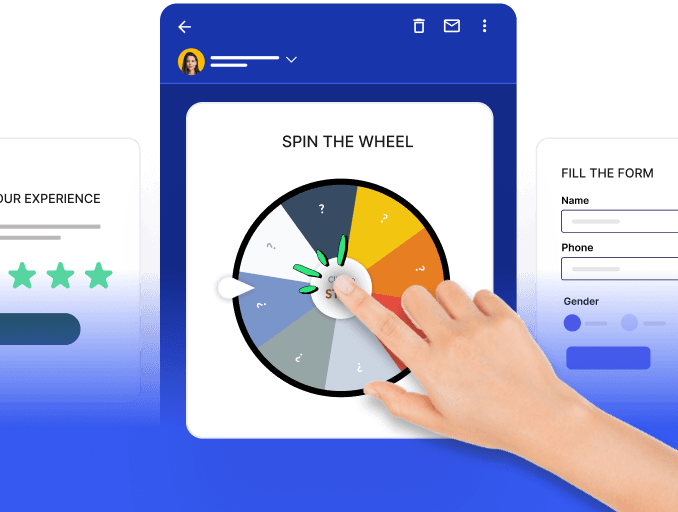Imagine having customers walk into your store intending to buy one item, but leave with five. Isn’t that a favorable situation? Now, step into the customer's shoes and imagine the convenience of purchasing everything you need in a discounted bundle. That's the beauty of product bundling —a win-win scenario where customers get value-packed deals, and businesses boost sales.
Whether you're a small ecommerce startup or an established retail giant, product bundling opens doors to endless possibilities for growth and customer satisfaction. In this blog, we'll delve into the advantages of product bundling, share effective implementation strategies, and provide valuable tips for maximizing its impact on your business.
Table of contents
What is product bundling?
Product bundling is a strategy where businesses package related products or services to offer customers a better deal and enhance their overall experience.
Imagine a customer shopping for a new laptop. Instead of just selling them the laptop, a savvy business would bundle it with a carrying case, a mouse, and antivirus software at a discounted price. This not only saves customers money but also enhances their purchase by providing everything they need in one package - all while leading to increased revenue for your business.
Why is it an essential business strategy?
Firstly, product bundling boosts sales by enticing customers with attractive deals they can't resist. Who doesn't love a good bargain, right?
Secondly, it encourages customers to buy more items at once, increasing the average transaction value and maximizing revenue.
Moreover, bundling can help businesses stand out in a competitive market. When you offer bundled packages that cater to different customer needs and preferences, you create a unique value proposition that sets you apart from the rest.
In summary, product bundling is not just about selling more; it's about providing value, convenience, and a competitive edge. It's a great strategy that benefits both businesses and customers alike.
Types of product bundling
Here's a breakdown of the different types of product bundling you can use to soar your business:
1. Pure bundling
These bundles are like a complete package deal, offering a set of products that perfectly complement each other, providing convenience and value to customers plus boot your sales. These products are designed to be used together and are only sold as a set. Imagine a curling iron with multiple attachments. You can't buy the machine without the attachments, and vice versa.
2. Mixed bundling
Mixed bundles offer products together at a discounted price, but you also have the option to buy the items individually, unlike pure bundles. A Harvard Business School Study found that Nintendo increased unit sales by up to 100,000 units using mixed bundling in a single campaign.
Imagine offering a mixed product bundle that combines a yoga mat, resistance bands, and a water bottle – It’s perfect for a home workout routine. This not only increases average order value but also caters to busy customers who want a one-stop shop for their fitness needs.
3. New product bundles
When launching a new product, bundling it with complementary items can boost its visibility and appeal. You can bundle new products with existing popular items. This piggybacks on the success of your established product, generating excitement for the new one. Imagine launching a fitness tracker and bundling it with a discounted heart rate monitor – a perfect combo for health-conscious buyers.
4. Cross-sell bundling
Cross-selling is all about suggesting complementary products similar to the "frequently bought together" feature seen in many online stores. A study by McKinsey's reveals that 35% of Amazon purchases stem from recommendations, including bundled offerings. Think about what a customer typically buys with your main product and bundle them together.
For instance, a new laptop would go well with a wireless mouse and laptop bag. It reminds customers of additional items that they might need, increasing the average order value and also sales for your business. The items aren't necessarily bundled together in a discounted package, but they are presented together to encourage a purchase.
5. Gifting bundles
These bundles are curated product packages designed specifically for gifting occasions like birthdays, holidays, or special events. Pre-made gift bundles are lifesavers for both you and your busy customers.
For instance, bundles like a spa day kit that would contain bath salts, a soothing lotion, and a luxurious eye mask. This pre-curated gift set makes it easy for customers to find the perfect gift and boosts sales during non-peak seasons.
6. Inventory clearance bundles
These bundle slow-moving inventory with popular items at a discount to clear stock while driving sales. This is a win-win. Customers get a great deal, and you clear out old inventory or dead stock to make space for new arrivals. Think razors with discounted shaving cream, or phone cases bundled with screen protectors.
7. Buy-One-Get-One bundles
This age-old tactic is a customer favorite. Offer a free or discounted product with the purchase of another item. Buy a T-shirt, get another one 50% off. It creates a sense of excitement, and a clear discount, perfect for driving sales. This also encourages repeat purchases and boosts customer loyalty.
Advantages of product bundling for businesses
Here’s why product bundling is great for your business:
Increases average order value (AOV): Bundling encourages customers to buy more than they initially planned, boosting your AOV and overall revenue. This is because they automatically increase the total number of products in an average customer’s cart
Clears inventory: Bundling can help you move slow-moving or excess inventory. This not only frees up space but also turns stagnant stock into revenue and makes space for new items.
Attracts new customers: Bundles attract attention. When customers see attractive bundles, they're more likely to try your products, bringing in new customers who might not have purchased from you otherwise.
Enhances customer experience: Bundles simplify shopping for customers. Besides the discount, they get everything they need in one package, saving time and effort, which boosts customer experience, satisfaction and loyalty.
Creates differentiation: There’s scope for you to stand out from competitors by offering unique bundles tailored to your audience's needs and preferences. This sets you apart and gives customers a reason to choose your brand.
Simplifies marketing: Promoting bundled offers simplifies your marketing efforts. It's easier to communicate the value of a bundle compared to individual products in the same bundle, making your marketing messages more impactful.
Disadvantages of product bundling
But, don't bundle blindly. Here’s the flip side:
Complex pricing strategies: Determining the right pricing for bundles can be tricky. Businesses need to carefully balance the perceived value of the bundle with profit margins, avoiding pricing that may seem too high or too low and ultimately hurt your profits.
Customer preferences: Not all customers may be interested in bundled offers. Some may prefer to choose individual items based on their specific needs or budget, leading to a mismatch in customer expectations.
Value perception: While bundling creates value perception, it can also backfire if customers perceive the bundle as including unnecessary or unwanted items. Businesses need to clearly communicate the value of each item in the bundle and the benefits of purchasing the bundle as a whole.
Cannibalization: Bundling can sometimes cannibalize sales of higher-margin products when they are included in lower-priced bundles. This can impact overall profitability if not managed effectively.
Promotion dependency: Businesses may become overly reliant on bundling as a promotional strategy, making it challenging to sustain sales without continuous bundling offers. This can create pricing expectations among customers that may be difficult to meet in the long run.
How to craft winning product bundles
We've broken down winning strategies on how to create irresistible bundles that customers can't resist. Here’s how:
Step 1: Know your customer
Think of your ideal customer profile: Who are your customers? What are their needs and wants? Imagine a busy mom as your ideal customer profile – a pre-made "lunchbox essentials" bundle with a water bottle, bento box, and reusable snack bags would be a lifesaver for her!
Listen to the data: Look at your sales history. What products do your customers buy together? Bundle those for ultimate convenience. For example, if phone chargers and cables often fly off the shelves together, create a bundle to make buying them a breeze.
Step 2: Craft compelling bundles
Provide value: The key to a successful bundle is perceived value. Customers should feel like they're getting a great deal. Offer a discount on the bundled item so they are cheaper compared to buying them separately.
Select the right products: Don't just throw things together. Bundles should be a match made in shopping heaven. Think of a coffee maker paired with a bag of coffee or a camera bundled with a carrying case.
Offer variety: Offer different bundle options. Maybe a basic bundle with the essentials and a premium bundle with extra goodies. This caters to different budgets and needs.
Step 3: Make it easy to buy
Showcase, don't hide: Put your bundles front and center on your website and marketing campaigns. Highlight the value proposition and make it easy for customers to find what they're looking for.
Communicate clearly: Be crystal clear about what's included in each bundle. Use high-quality images and detailed descriptions to avoid any confusion.
Leverage FOMO and scarcity: Create limited-time bundles or seasonal offers to create a sense of urgency and encourage impulse purchases. "Weekend-only bundles”, for instance, can be a huge hit and bump up your weekend sales.
Step 4: Test, track, and tweak
Don't be afraid to experiment: Try different types of bundles and see what resonates best with your customers. A/B test different price points, product combinations, and marketing messages to find the right match.
Track your bundles: Track the performance of your bundles. See which ones sell best and adjust your strategy accordingly. Analyze what works and what doesn't to keep optimizing your bundles for maximum impact.
Tips for implementing a successful product bundling strategy
Here are some pro tips to turn those bundles into sales:
Tip #1: Sweeten the deal
Power of discount: People love a bargain! Offer a clear discount on the bundled items compared to buying them separately. Highlight the savings percentage to make the value undeniable.
Offering freebies: Consider adding a small freebie to a higher-priced bundle. It could be a sample, a travel-sized product, or something relevant to the bundle theme. This little extra incentive can tip the scales in your favor.
Free shipping bonus: Free shipping is a powerful motivator. Offer free shipping on orders that include a bundle. This makes the customers more inclined towards including a bundle in their shopping cart, thereby encouraging them to spend more.
Tip #2: Focus on the presentation
Picture-perfect presentation: Showcase your bundles beautifully. Use clear, well-lit photos that show each item and the overall value of the bundle.
Clear descriptions: Don't skimp on the descriptions. Clearly list all the products included, highlighting their key features and benefits. Make it easy for customers to understand exactly what they're getting.
Call to action clarity: Use clear calls to action like "Add to Cart" or "Buy Now" to make it easy for customers to take the next step and purchase the bundle.
Tip #3: Promote properly
Targeted marketing: Don't just throw bundles out there – promote them strategically! Use targeted ads and social media campaigns to reach customers who are likely to be interested in the specific products you've bundled.
Email engagement: Highlight your bundles in email marketing campaigns. Feature them in newsletters, special offer emails, or cart abandonment sequences to capture customer attention. You can even use an email service provider (ESP), like Mailmodo, to design and send automated email campaigns.
Limited-time hype: Create a sense of urgency with limited-time bundles. Promote them as "Weekend Wonders" or "Seasonal Steals" to encourage impulse purchases and drive sales.
Download the Email Design for Newbies
Conclusion
Product bundling isn't a magic trick, but it can feel like one when it comes to boosting sales and customer satisfaction. By strategically crafting bundles that offer clear value, solve customer needs, and are presented enticingly, you can turn this strategy into a profit powerhouse. Remember, successful bundling is about more than just throwing products together. It's about understanding your customers, creating a win-win situation, and making the buying process a breeze. So, don't wait – experiment, get creative, and bundle your way to success!







